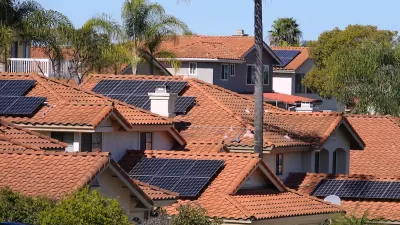Tom Stoelker reports on the progress of New York City's Zone Green initiative, a comprehensive effort to make it easier to construct green buildings and retrofit existing ones, that passed the City Planning Commission unanimously this past week.
Zone Green is intended to update the city's zoning code to remove impediments that prevented owners from building green or retrofitting their buildings, and is designed to encourage homeowners and landlords to invest more in greening their properties.
According to Stoelker, "Building owners will now be able to install a green roof, add solar panels, and sunshading without a punitive reduction of the floor area ratio." The zoning changes allow more leeway in the size and extent of screen and sunshades, additional roof height for greenhouses, green roofs, and solar panels, and additional depth for building recladding for insulation purposes.
According to the City, "The program is a key component of the Bloomberg Administration's PlaNYC for greening the City's roughly one million buildings, which cost $15 billion per year to power and heat, and account for 80% of the city's greenhouse gas emissions. Improving the energy efficiency of our buildings and enabling them to produce their own clean energy represents a critical contribution to the global environment."
FULL STORY: Emerald City

Study: Maui’s Plan to Convert Vacation Rentals to Long-Term Housing Could Cause Nearly $1 Billion Economic Loss
The plan would reduce visitor accommodation by 25,% resulting in 1,900 jobs lost.

Alabama: Trump Terminates Settlements for Black Communities Harmed By Raw Sewage
Trump deemed the landmark civil rights agreement “illegal DEI and environmental justice policy.”

Why Should We Subsidize Public Transportation?
Many public transit agencies face financial stress due to rising costs, declining fare revenue, and declining subsidies. Transit advocates must provide a strong business case for increasing public transit funding.

Paris Bike Boom Leads to Steep Drop in Air Pollution
The French city’s air quality has improved dramatically in the past 20 years, coinciding with a growth in cycling.

Why Housing Costs More to Build in California Than in Texas
Hard costs like labor and materials combined with ‘soft’ costs such as permitting make building in the San Francisco Bay Area almost three times as costly as in Texas cities.

San Diego County Sees a Rise in Urban Coyotes
San Diego County experiences a rise in urban coyotes, as sightings become prevalent throughout its urban neighbourhoods and surrounding areas.
Urban Design for Planners 1: Software Tools
This six-course series explores essential urban design concepts using open source software and equips planners with the tools they need to participate fully in the urban design process.
Planning for Universal Design
Learn the tools for implementing Universal Design in planning regulations.
Smith Gee Studio
Alamo Area Metropolitan Planning Organization
City of Santa Clarita
Institute for Housing and Urban Development Studies (IHS)
City of Grandview
Harvard GSD Executive Education
Toledo-Lucas County Plan Commissions
Salt Lake City
NYU Wagner Graduate School of Public Service



























